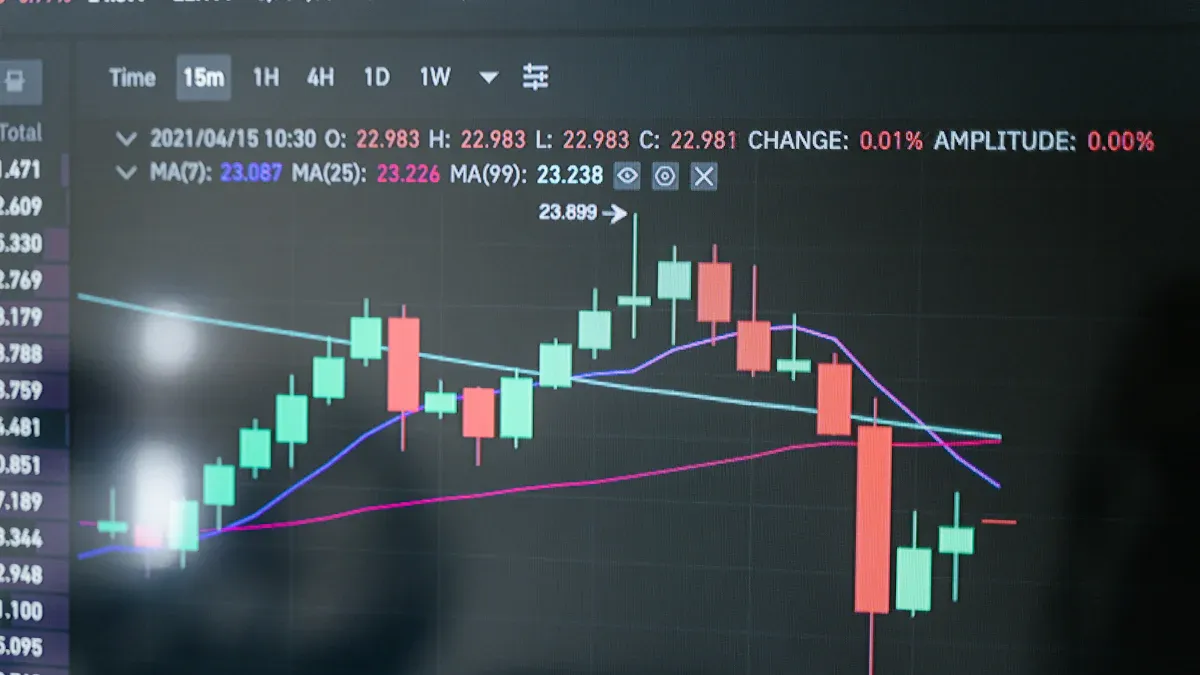Image Source: pexels
Investors often wonder what drives certain investments to outperform others. An analysis of high-end investment cases: the secrets behind success reveals patterns that distinguish success from failure. These cases provide valuable insights into decision-making, market dynamics, and risk management. What truly separates a winning investment from one that falters? The answer lies in understanding these critical factors.
Key Takeaways
- Good investments match market trends and timing. Learn about economic changes to find chances early.
- New ideas help stay ahead in business. Companies that focus on creative plans get lasting investments.
- Spreading money lowers risk. Invest in different things to stay safe during bad markets.
Case Studies of Successful Investments
Warren Buffett’s Investment in Coca-Cola
Warren Buffett’s investment in Coca-Cola exemplifies the power of long-term vision and strategic decision-making. He recognized the company’s potential during a period of uncertainty, including the infamous "New Coke" incident. Buffett valued Coca-Cola’s strong brand identity and its ability to resonate with consumers globally. The company’s strategic expansion into international markets and diversification beyond sugary beverages further solidified its growth trajectory. Coca-Cola’s consistent generation of free cash flow and its shareholder-friendly practices, such as regular dividend payments, made it an attractive investment. Buffett’s foresight and patience turned this investment into one of the most iconic success stories in financial history.
A Breakthrough Technology Startup: Airbnb’s Early Growth
Airbnb’s early growth strategy highlights the importance of innovation and adaptability in the technology sector. The company initially leveraged platforms like Craigslist to gain visibility. By posting listings on Craigslist, Airbnb tapped into a large audience seeking alternative accommodations. This approach validated the demand for unique travel experiences and provided immediate exposure. Additionally, Airbnb automated the process of posting listings, which significantly boosted user acquisition. The company’s success stemmed from its ability to understand evolving customer needs and aggressively pursue market opportunities. This strategic focus allowed Airbnb to establish itself as a leader in the sharing economy.
A High-Growth Stock Market Play: Tesla’s Market Domination
Tesla’s rise to market dominance showcases the impact of innovation and favorable market conditions. Several factors contributed to its success:
- Revolutionary technology and a focus on renewable energy.
- Growing investor optimism surrounding electric vehicles (EVs).
- Inclusion in the S&P 500 Index, which drove a surge in its stock price.
- Broader trends favoring clean energy and technology investments.
Tesla’s ability to align its vision with these trends enabled it to capture significant market share. Its strategic expansion and commitment to innovation solidified its position as a leader in the EV industry.
Key Factors Behind Success
Market Trends and Timing
Successful investments often align with prevailing market trends and capitalize on optimal timing. Investors who monitor economic shifts, technological advancements, and consumer behavior can identify opportunities before they become mainstream. For instance, Tesla’s rise coincided with growing interest in renewable energy and electric vehicles. Timing also plays a critical role. Entering a market too early may result in missed opportunities, while late entry can lead to oversaturation. By staying informed and acting decisively, investors can position themselves to benefit from emerging trends.
Innovation and Competitive Advantage
Innovation drives growth and sustains competitive advantage in high-end investments. Companies that prioritize innovation transform creative ideas into practical solutions, meeting consumer demands and improving efficiency. For example, Iberdrola’s collaboration with startups and adoption of new technologies strengthened its innovation strategy. This approach enabled the company to lead in its industry while enhancing operational value. Neglecting innovation risks obsolescence, as competitors with advanced solutions often dominate the market. Businesses that innovate consistently maintain relevance and attract long-term investment.
Strategic Decision-Making and Leadership
Effective leadership and strategic decision-making significantly influence investment success. Companies that prioritize customer experience, adopt sustainable practices, and invest in flexible systems often outperform competitors. Strategic decisions, such as expanding into new markets or adopting emerging technologies, open new revenue streams and enhance financial health. Additionally, organizational agility allows businesses to adapt quickly to market changes, ensuring resilience. Strong leadership fosters a culture of innovation and positions companies for sustained growth.
Investment Strategies
Value Investing and Identifying Undervalued Assets
Value investing emphasizes purchasing stocks priced below their intrinsic value. This principle, championed by Benjamin Graham, has guided many successful investors. Stocks often become undervalued due to market psychology, company-specific challenges, or broader economic conditions. These situations create opportunities for those who can identify them.
Investors assess intrinsic value using metrics such as price-to-earnings ratios and book value. They also evaluate management quality and industry trends. A critical aspect of value investing is maintaining a margin of safety, which acts as a buffer against market volatility and estimation errors. However, thorough research is essential to avoid value traps—stocks that appear undervalued but fail to realize their potential. By adhering to these principles, investors can uncover hidden gems in the market.
Diversification to Minimize Risk
Diversification remains one of the most effective strategies for managing investment risk. By spreading investments across various asset classes, industries, and geographic regions, investors reduce their exposure to any single market downturn. For instance, a portfolio that includes stocks, bonds, and real estate is less likely to experience significant losses during economic turbulence.
This approach aligns with the principle of not putting all eggs in one basket. Diversification ensures that even if one investment underperforms, others may offset the losses. It also allows investors to participate in multiple growth opportunities, enhancing the potential for long-term returns. A well-diversified portfolio is a cornerstone of prudent investment management.
Long-Term Thinking and Patience
Long-term thinking and patience are vital for achieving consistent investment success. Investors who resist impulsive decisions during market fluctuations often fare better over time. Historical data supports this, showing that holding investments for extended periods significantly reduces the likelihood of losses. For example, the probability of negative returns drops from 23% for one-year investments to just 3% for ten-year periods.
This strategy mirrors the findings of the famous "marshmallow test," where individuals with better impulse control achieved greater success later in life. In investing, this translates to avoiding speculative trading during market bubbles and focusing on disciplined, long-term strategies. By staying invested through market cycles and adhering to a clear plan, investors can maximize their financial outcomes.
Risk Management

Image Source: pexels
Importance of Due Diligence
Conducting thorough due diligence is essential for mitigating risks in high-end investments. Investors must evaluate multiple aspects of a company to make informed decisions. Key steps include:
- Company Capitalization: Assessing market capitalization helps determine the company’s size and financial stability.
- Revenue and Margin Trends: Analyzing revenue and profit trends over the past two years provides insights into financial health.
- Competitors and Industries: Comparing the company with its competitors reveals its market position and growth potential.
- Valuation Multiples: Reviewing metrics like price-to-earnings ratios highlights whether the investment is overvalued or undervalued.
By following these steps, investors can identify potential red flags and ensure their investments align with their financial goals.
Balancing Risk and Reward
Balancing risk and reward requires a strategic approach tailored to individual circumstances. Investors can achieve this by:
- Understanding their personal risk tolerance and aligning it with their investment choices.
- Considering their time horizon, as longer periods allow for higher risk-taking.
- Diversifying portfolios to reduce exposure to market volatility.
- Investing in long-term assets to weather short-term fluctuations.
This approach ensures that investors can pursue growth opportunities while minimizing potential losses.
Contingency Planning for Unforeseen Events
Unforeseen events can disrupt even the most well-planned investments. Effective contingency planning includes:
- Implementing hedging strategies, such as stop-loss orders, to limit losses.
- Using options strategies as insurance against adverse market movements.
- Diversifying assets across sectors and geographies to spread risk.
- Employing contingent immunization in fixed-income portfolios to shift to defensive positions when necessary.
These measures provide a safety net, ensuring that investors remain resilient in the face of unexpected challenges. A proactive risk management framework safeguards portfolios and enhances long-term success.
Lessons for Modern Investors
Adapting Strategies to Current Market Conditions
Modern investors must adapt their strategies to align with evolving market conditions. Economic shifts, technological advancements, and geopolitical events often reshape investment landscapes. Investors who remain flexible and informed can capitalize on emerging opportunities. For instance, during periods of high inflation, allocating assets to sectors like commodities or real estate can help preserve purchasing power. Similarly, in a low-interest-rate environment, focusing on growth stocks or alternative investments may yield better returns. Staying updated on market trends and adjusting portfolios accordingly ensures resilience and long-term success.
Learning from Past Successes and Failures
Analyzing past investment outcomes provides valuable lessons for modern investors. Successful cases, such as Warren Buffett’s Coca-Cola investment, highlight the importance of patience and identifying undervalued assets. Conversely, failures often stem from neglecting due diligence or overexposure to high-risk assets. Investors should study these examples to refine their decision-making processes. By understanding what worked and what did not, they can avoid repeating mistakes and adopt strategies that have proven effective over time.
Building a Resilient Investment Portfolio
A resilient portfolio balances risk and reward while adapting to market uncertainties. Key components include:
- Investing in quality dividend-paying equities that are undervalued.
- Allocating to direct lending, real estate debt, equity, and infrastructure for income enhancement.
- Including core fixed income as a diversifier.
- Adding assets to mitigate inflation risks.
- Considering alternative assets for improved diversification.
Diversification remains crucial for managing risk and enhancing returns. Maintaining price discipline and focusing on steady compounding further strengthens portfolio resilience. These strategies ensure that investors can weather market fluctuations and achieve sustainable growth.
The analysis of high-end investment cases: the secrets behind success reveals actionable principles that investors can adopt to enhance their financial outcomes. To achieve success, individuals should:
- Create realistic financial goals segmented into short-, mid-, and long-term phases.
- Invest early and regularly to leverage compounding.
- Build a diversified portfolio to mitigate risks.
- Minimize taxes and fees to maximize net returns.
- Rebalance portfolios periodically to align with life stages.
Additionally, investors should assess their financial situation and risk tolerance before selecting strategies. Passive index investing offers built-in diversification, while momentum investing capitalizes on market trends. Staying disciplined and adopting a long-term vision ensures resilience during market volatility. By applying these principles, investors can refine their strategies and achieve sustainable growth.
FAQ
What is the most critical factor for investment success?
Understanding market trends and timing is crucial. Investors who align their strategies with emerging opportunities often achieve better outcomes.
How can investors minimize risks effectively?
Diversification is key. Spreading investments across asset classes, industries, and regions reduces exposure to market volatility and enhances portfolio stability.
Why is long-term thinking important in investing?
Long-term thinking allows investors to weather market fluctuations. It also maximizes the benefits of compounding, leading to more consistent financial growth over time.
💡 Tip: Patience and discipline are essential traits for successful investing. Avoid impulsive decisions during market turbulence to stay on track with long-term goals.




